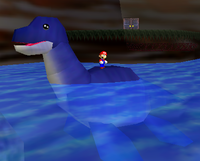Dorrie
Template:Species-infobox Template:LLquote
Dorrie is a large, friendly Plesiosaurus (or Loch Ness Monster) that was first seen in Super Mario 64. He helps Mario, Luigi and friends cross water or reach higher areas.
History
Super Mario series
Super Mario 64
The first known Dorrie from Super Mario 64 lives in an underground lake in the Hazy Maze Cave. He spends his days swimming in circles, but will gladly give Mario a ride if he gets on his back. It is also possible to steer Dorrie by carefully climbing up onto his head; Mario will lose control of movement for a moment, then the player can control Dorrie by facing the direction they want to go in. Ground Pounding on his back or approaching his neck will cause him to lower his neck, making this task easier. A sign near the lake in which he takes residence states that he might eat visitors if they get too close, although he otherwise proves to be a harmless creature.
Super Mario 64 DS
Dorrie also appears in Super Mario 64 DS. He now wears goggles, and resembles the Dolphins in Super Mario World. He fulfills the same role as in Super Mario 64. When Wario is unlocked, Dorrie sometimes has Wario's Cap on his head (unless the player is playing as Wario).
New Super Mario Bros.
Dorrie returns in New Super Mario Bros., and has goggles like in Super Mario 64 DS. Mario can ride on his back to cross large bodies of toxic water in certain levels of World 4. If Mario does a Ground Pound on Dorrie, he will move faster through the water. There are two sizes of Dorrie in this game.
Mario Party series
Dorrie is a recurring minor character in the Mario Party series, although only directly appearing in a few games, such as Mario Party 3 and Mario Party Advance; a lot of aquatic equipment in the Mario Party series, such as boats, are based on Dorrie.
Mario Party 2
Dorrie makes a small cameo in Mystery Land in the background lake, resembling the Loch Ness Monster.
Mario Party 3
Dorrie is seen in an Item Minigame called Dorrie Dip. He also makes a cameo in the background of the board Creepy Cavern.
Mario Party Advance
In Mario Party Advance, a Dorrie reveals that he is lonely after scaring away Mr. E. If Yoshi comes, they'll become friends and Dorrie gives him a Gaddget, the Soil Sonar. The credits show that Yoshi ought to visit him soon. It says that he hasn't seen him in a while, or as it says, ages.
Mario Party 5
In Mario Party 5, plastic Dorries appear in the battle minigame Tug-o-Dorrie.
Gallery
- Mp3 Dorrie Items.png
- MP5 TugoDorrie.JPG
- Dorrie sprite.PNG
Names in Other Languages
Trivia
This trivia section is overly long. Please relocate any relevant information into appropriate sections and articles.
- In the Japanese version of Super Mario 64, Dorrie is referred to as "Doshi", most likely a parody of the Loch Ness Monster (who is commonly referred to by the nickname "Nessie", which is pronounced "Neshi" in Japanese) and Yoshi. In the game's German version, he is actually called Nessie. Also, the English version of where he is in Mario Party Advance is punned on Loch Ness, Scotland, where Nessie comes from - Loch Dorrie.
- Dorrie is most likely based off of the prehistoric swimming reptile, the Plesiosaurus; which is also what the Loch Ness Monster is based off of.
- Although Dorrie is male, Mario Party 3 uses feminine pronouns in some mini-games featuring him.
- Dorrie has unused animations in New Super Mario Bros. for facing forwards and backwards.
- In Super Mario 3D World, an animal named Plessie looks similar to Dorrie and with the same task appears.
- Dorrie may be loosely based on Yoshis. Its Japanese name is similar to Yoshi's name, and Yoshi called himself a "Super Dragon" in Super Mario World (as opposed to Dorrie being a sea dragon).
- In addition, it shares the same Japanese name as Bahamutt, which made its appearance a bit earlier. It could be that these dragons are closely related, as they also have a close physical resemblance disregarding their obvious limb and eye design differences.

